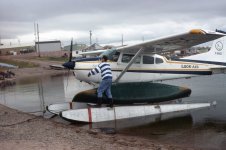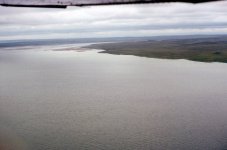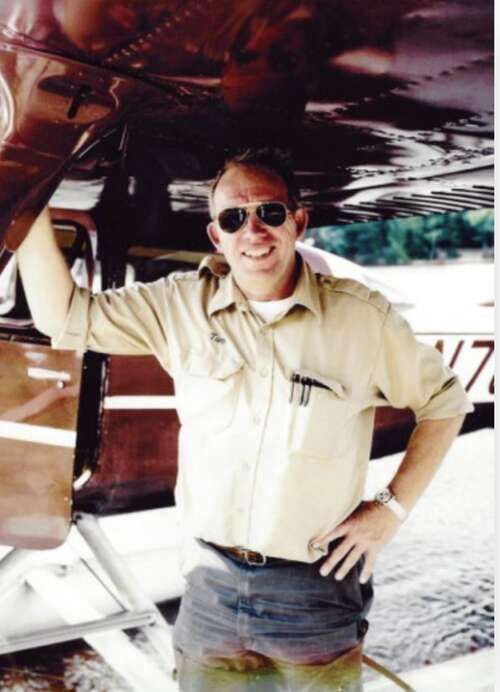I had some friends cancel a trip in Alaska due to a recently added "fuel surcharge". I don't know how much it was, though.I wonder how much inflation will hurt float plane plans. We aren’t considering it for this and likely next year, unless something happens .
-
Happy 2nd Nobel Prize, Marie Curie (1911)! 🥈⚛️🧪
You are using an out of date browser. It may not display this or other websites correctly.
You should upgrade or use an alternative browser.
You should upgrade or use an alternative browser.
Float Plane Stories
- Thread starter Glenn MacGrady
- Start date
We have been using Bluewater Aviation in Bissett, Manitoba for many years to access lakes in Atikaki Provincial Park. They did reluctantly add an under 10% fuel surcharge this summer. By arranging friends to use our backhauls and use the same canoes 10 paddlers enjoyed various length trips and it only cost us $515 US each for the whole thing. We had been flown in 50 miles and about the same for exit.
A sad part was that our long time pilot Jonathon had been killed when a wing broke off his Otter shortly after our final flight with him a few years ago. A wing strut attachment had broken on the 1950's era Otter.
A sad part was that our long time pilot Jonathon had been killed when a wing broke off his Otter shortly after our final flight with him a few years ago. A wing strut attachment had broken on the 1950's era Otter.
- Joined
- Aug 21, 2018
- Messages
- 1,808
- Reaction score
- 4,516

In 1993 Kathleen and I canoed 950 km (600 miles) down the Thelon River, ending our trip in Baker Lake at the head of Chesterfield Inlet on Hudson Bay. Our pilot, Paul, is loading the float plane and inspecting its checkpoints for our flight back to Fort Smith in the Northwest Territories.

Paul took off easily into the north wind, and we banked south, our direction "locked in" by the global positioning system. Below, the Barren Grounds stretched endlessly, dominated by lakes and water courses. We flew silently across the unchanging landscape. Had Kathleen and I really traversed this open emptiness alone?
We crossed Dubawnt Lake, an immense body of water, purported by Paul to be as large as Massachusetts. A short time later we landed at Damant Lake for refuelling. The float plane coughed and wheezed, and sputtered against the shore next to the ubiquitous red-and-yellow fuel drums.
"Cracked fuel line," Paul remarked, with incredible nonchalance. “I'll try to fix it. If we try to take off, we might explode." In fact, I thought I had been smelling gas.
We watched nervously as Paul removed the front fuselage and unpacked his screw drivers and other tools.
"I could jerry-rig this to work, but I don't want to take a chance. I'll radio for help."

Kathleen and I wandered onto the esker, then back down into the trees. We settled in the shelter of a hill away from the strengthening winds. Our sausages, peanut butter, crackers and gorp made a good meal. Paul joined us after relaying a message to Fort Smith, through Yellowknife. As the afternoon lengthened into evening, we considered putting up the tent. Maybe I could catch fish for dinner. I was hoping not to be saved just yet, as I very much wanted to continue living in the Barren Grounds. All too soon, however, we heard the drone of an approaching plane, which landed at 8:30 p.m.
Dick, the manager and mechanic of Loon Air held the required replacement part in his hand, and he immediately began repairing the broken fuel line. After quickly completing the repair with a 50-cent piece of tubing, Dick suggested that Kathleen and I should travel in the "rescue" plane. Even though we couldn't make Fort Smith before nightfall, both pilots wanted to at least get off the Barrens. Thekulthili Lake, about 1 hour away, became our destination. Paul took off first, without incident. We followed, but soon passed the first plane, which was slowed by our canoe strapped to the pontoon. Although not yet legally night, the lake looked dark as our pilot Don, who had flown us into the Thelon River six weeks ago, flew low over the water surface, looking for rocks and shoals. Paul landed about 5 minutes later, and we all tied up to shore in front of a rustic fishing lodge.
Once our sleeping bags were spread on the bunks we enjoyed a beer, compliments of Dick and Loon Air. The rest of the evening passed quickly, as we listened to stories of flying and mishaps in this vast, empty land.
The next morning we woke to a heavy mist hanging over the lake. As we drank our coffee, we stared toward the end of the lake, searching hopefully for signs that the fog may be lifting. Don and Paul studied the maps, looking for water routes above which they could fly safely. Don was ready when the far shore became visible, so we taxied down the lake and took off for Fort Smith.
The fog soon thickened, and I strained ahead to see potential obstacles that might suddenly emerge from the mist that now covered the land. Don banked sharply, and turned back and landed on a small, unnamed patch of water barely visible beneath the thickening mist. Rocky, steep, well-treed banks surrounded the lake.
Don flew in fog only when he could see lakes, which provided potential emergency landings. He never flew in fog over land. We appreciated Don's cautious motto: "Never close the back door. When the Barrens bite, they bite hard."
About an hour later, the ceiling lifted slightly, revealing the lake's far shore. After taking off for the second time this morning, the southern horizon continued to become brighter. Just before lunch we taxied up to the Loon Air float dock on Four Mile Lake. Paul didn't arrive with our gear and canoe until around 4:00 pm; he had been unable to leave the fishing lodge this morning, as the fog returned to Thekulthili Lake only moments after we had flown away.
We returned to the Pelican restaurant for the pizza we'd been looking forward to since arriving in Baker Lake. After dinner Don, Paul and another young pilot joined us at our Fort Smith campsite for beer and more bush-pilot stories. The skill of these pilots had safely transported us to and from the Thelon River. It seemed fitting to end our adventure in their company.
Last edited:
Great story. Glad it worked out well for everyone.
I have to admit, the incessant traffic over wilderness takes some of the air out of my sails.
After getting ourselves and gear shuttled in to a bush landing on the tundra my two friends and myself watched the Cessna 206 on tundra tires take off. After the plane got airborne the pilot made a hairpin turn and started coming back towards us. It quickly became apparent that the pilot was going to intentionally buzz us. Standing there watching the plane coming towards us we all had the same thought of not ducking. At the last second we all hit the ground, loosing the game of chicken. I would like to think that we were never in danger and that the plane was higher than it appeared, but at the time it sure didn't feel that way.
I think the pilots do know their margin of error but when you are watching one coming in hot and low you forget that. Most bush pilots circle at least once checking for rocks or logs in the water. I was crossing a lake that had an outpost cabin on it. In the distance I saw a plane bearing in on my position. It was not going to circle and I had no idea if the pilot could see me. My double blade was churning fast as I tried to get out of the way. As the plane dropped in I looked back over my shoulder to see the passengers staring at me with mouths agape. I looked back as it was time to dive over the side if needed. The cabin was next to my exit and as I paddled by the pilot called over to me " I thought that was you."
The skies over Long Lake [NY} are quieter this week.

 www.adirondackexplorer.org
www.adirondackexplorer.org
Helms was one of the two active float plane operators in the adirondacks. I never saw or heard anthing negative about Mr. Helms or his flight oprations. He stayed withing the guidelines and obeyed well known regulations and wilderness policy.
The other active Adirondack flier is another question.

Adirondack skies missing Long Lake legend
Thomas Helms, a pilot, professor and fixture of Long Lake, in the Adirondack Mountains, died last month at 76.
 www.adirondackexplorer.org
www.adirondackexplorer.org
Helms was one of the two active float plane operators in the adirondacks. I never saw or heard anthing negative about Mr. Helms or his flight oprations. He stayed withing the guidelines and obeyed well known regulations and wilderness policy.
The other active Adirondack flier is another question.
I spent part of 2 years working on a mining project in SE Alaska with 150 inches of rain. We would fly to Ketchikan and typically take a Beaver on floats 70 miles east to the mine site. There we would meet up with a helicopter, usually a Hughes 500, sometimes a Bell Ranger.
We were dong field work in the bush with no roads and the only trails were made by bear and moose. It is so wet that moving around is not easy. All day hiking might mean 6-7 miles. So we used helicopters to get around. Most of the work was timber cruising, stream sampling and gauging and soils mapping.
I took my wife on a tour of the mine site in a Cessna on floats from Ketchikan some 25 years later.
My Dad lives 1 mile from the float plane terminal of Kenmore Air on the north end of Lake Washington. We used to run his 42 foot power boat up to Roche Harbor on the north end of San Juan Island next to the Canadian border. Then we could charter a flight back to his house. Kenmore uses a lot of Beavers with turbo prop engines. They fly at around 4000 feet so it is possible to see everything going home over all of the San Juan Islands. My uncle used to have a 35 foot sailboat and we ran that boat up there too. It would take about 2 days from Seattle. Nothing like getting a ride to Kenmore Air, getting in a 6 seater with a duffle bag and having the plane taxi up to the dock next to Dad's boat. Then we just step out with a duffle bag and get aboard.
I had two uncles that were bush pilots in Alaska. One moved outside and lived on a boat in Anacortes. The other one gave up bush flying and retired from it. He had a nice safe bunch of routes around Puget Sound. He was home every night. One day his plane went into the salt water upside down and he was killed. A life well lived involves some risk.
We were dong field work in the bush with no roads and the only trails were made by bear and moose. It is so wet that moving around is not easy. All day hiking might mean 6-7 miles. So we used helicopters to get around. Most of the work was timber cruising, stream sampling and gauging and soils mapping.
I took my wife on a tour of the mine site in a Cessna on floats from Ketchikan some 25 years later.
My Dad lives 1 mile from the float plane terminal of Kenmore Air on the north end of Lake Washington. We used to run his 42 foot power boat up to Roche Harbor on the north end of San Juan Island next to the Canadian border. Then we could charter a flight back to his house. Kenmore uses a lot of Beavers with turbo prop engines. They fly at around 4000 feet so it is possible to see everything going home over all of the San Juan Islands. My uncle used to have a 35 foot sailboat and we ran that boat up there too. It would take about 2 days from Seattle. Nothing like getting a ride to Kenmore Air, getting in a 6 seater with a duffle bag and having the plane taxi up to the dock next to Dad's boat. Then we just step out with a duffle bag and get aboard.
I had two uncles that were bush pilots in Alaska. One moved outside and lived on a boat in Anacortes. The other one gave up bush flying and retired from it. He had a nice safe bunch of routes around Puget Sound. He was home every night. One day his plane went into the salt water upside down and he was killed. A life well lived involves some risk.
Honestly, the noisy plane traffic in WCPP detract from the wilderness experience. Same for western BWCA and Quetico.
That plane brings back memories - flew on it at least twice. Great memories of past trips.2018 WCPP. Our 1st and only fly-in. Landed on Irene Lake. We went south to Wrist Lake where there was the most berries I’ve ever seen. I portaged both solo canoes and 40-50 lb packs. Couldn’t do it now.
View attachment 132303View attachment 132319
Hi Black Fly,Honestly, the noisy plane traffic in WCPP detract from the wilderness experience. Same for western BWCA and Quetico.
Air travel is a fact of life in the northern bush. Without planes a lot of things don't happen. They are part of the fabric of living out there.
Sure it’s part of life, but it’s a matter of volume, frequency. Over commercialism never improves anything and people just don’t need to lower their expectations - they need to fight the trends.
“People always tell me not to be extreme. ‘Be reasonable!’ they say. But I never felt it did any good to be reasonable about anything in conservation, because what you give away will never come back—ever.” Martin Litton
“People always tell me not to be extreme. ‘Be reasonable!’ they say. But I never felt it did any good to be reasonable about anything in conservation, because what you give away will never come back—ever.” Martin Litton
I'd rather see a floatplane overhead than 4 stashed outboards at the next portage.
- Joined
- Aug 21, 2018
- Messages
- 1,808
- Reaction score
- 4,516
I’d rather see a floatplane overhead than a group of six canoeists on site despoiling my wilderness experience. That’s why Kathleen and I only occasionaly trip anywhere not easily reached other than by floatplane.
Last edited:
I’d rather see a float plane than a pool of acid mine drainage seeping into the watershed, but it’s not about a blank check. The industry is too large. Permitting system needs to be reined in. Conservation should be the overriding value. I can sit on my porch and listen to highway noise and noise IS pollution. It’s a matter of degrees, expectations.
I did not realize those were the only two options, either/or. Except when I was briefly stationed in the military in Ohio, I have not experienced paddling or camping in any such filthy waters region elsewhere. I couldn't wait to get my butt out of that awful state.I’d rather see a float plane than a pool of acid mine drainage seeping into the watershed, but it’s not about a blank check.
When a float plane operator overflies and deposits obviously low class clients at an already occupied remote campsite and they proceed to immediately get drunk and flagrantly openly violate environmental and public law and disrespect outdoor ethics and local wildlife without consequence, that kind of ruins any lasting good thoughts about the industry and float plane operations as a whole.
Last edited:
You see maybe one a day fly over? I’ve seen one every 10 minutes. Sometimes 2 at a time at loon lake in BWCA (primarily 1st nation traffic, I think). Several lakes like that in WCPP. Just too much traffic, over commercialization. Quiet is something I value in a trip. Probably different in Yukon, maybe I’ll get up there someday.
One of the best memories of mule packing on the continental divide was the absolute quiet. Wind is the most common noise maker there, but on a calm day the silence is deafening. Trout fishing on an alpine lake is magical.
One of the best memories of mule packing on the continental divide was the absolute quiet. Wind is the most common noise maker there, but on a calm day the silence is deafening. Trout fishing on an alpine lake is magical.
Last edited:
On the other hand, as a retired USAF flier (a navigator from dinosaur times), I welcome the sound in the Adirondacks of high flying fighter jets in training. Nearby Fort Drum has a simulated electronic bombing run for B-52 and other bombers to hone their skills, and in the past F-16s and A10s would fly in tandem dog fights high above, A10s woud fly tandem through the saddles between mountain heights, coming in surprise to the unsuspected, as was their mission. These days it is F-35 fighters. Ahhhh, the sound of freedom to my heart. When I was flying on active duty, I regualrly planned training routes over the adirondacks and my home below. You will never see them, they are too high.
On one of my Yukon 1000 races, on an unusually long straight stretch of the river, from my voygeur canoe bow seat I noticed several black specks on the horizon above the river in the distance. As they got closer I recognized them as a flight of F-16 fighter jets heading directly toward us. I did a welcome paddle wave and just as they got to us they each did a wing wave and then a vertical "burning climb", headiing with hot afterburner straight up verticallly away from us before rejoining in their flight formation. What a scene to appreciate for patriots. My son happened to be an F-16 pilot at the time, but was not then at the time deployed to Alaska for the current training activity then underway. After the canoe race I stopped at Eielson AFB Base flight Operations near Fairbanks to thank the pilots for the show.
On one of my Yukon 1000 races, on an unusually long straight stretch of the river, from my voygeur canoe bow seat I noticed several black specks on the horizon above the river in the distance. As they got closer I recognized them as a flight of F-16 fighter jets heading directly toward us. I did a welcome paddle wave and just as they got to us they each did a wing wave and then a vertical "burning climb", headiing with hot afterburner straight up verticallly away from us before rejoining in their flight formation. What a scene to appreciate for patriots. My son happened to be an F-16 pilot at the time, but was not then at the time deployed to Alaska for the current training activity then underway. After the canoe race I stopped at Eielson AFB Base flight Operations near Fairbanks to thank the pilots for the show.
Last edited:
Similar threads
- Replies
- 10
- Views
- 2K

